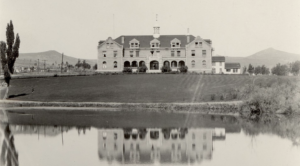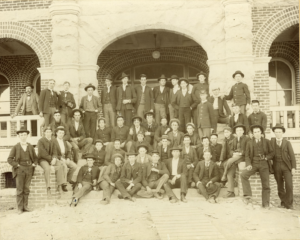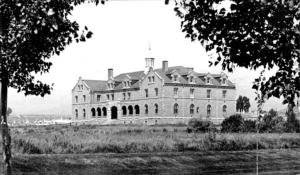The Haunting of Lincoln Hall
Winter 2022-2023
Haunted history at Nevada’s oldest dormitory.
BY KASSANDRA ANDICOECHEA-SCHMALING
In the winter of 1896, Lincoln Hall opened its doors at the University of Nevada, Reno as a dormitory for young men. The first students to climb its granite steps were likely shocked by the three-story building, stark and looming against sweeping sagebrush hills.
There are plenty of physical traces of Lincoln Hall’s first guests. Today, visitors will find tabletops carved with names and worn-down steps from a century’s worth of foot traffic. However, emotional traces of the building’s first occupants also linger, evident by the ghost stories that have been shared for nearly 120 years.

FOXY
Lincoln Hall’s most notorious haunting is the tragic death of James A. Champagne, better known as “Foxy.” Foxy is the most well-known apparition, often spotted wandering the first floor and basement. By all accounts, Foxy is not a sinister spirit, but a curious one.
On Feb. 11, 1906, Foxy met his tragic end in his dorm at Lincoln Hall. The 25 -year-old was well-liked and a good student, so it was a shock all when he was found dying from a gunshot wound. Debate stirred about his demise: was it accidental or suicide?
Hours before his death, Foxy was seen in good spirits opening letters and warming himself near the reading room fireplace. Suddenly, he stood and dropped a letter into the fire.
“Look out; there may be a check in that letter!” remarked a nearby friend.
“No, there is no check in that letter, and there never was,” Foxy replied solemnly.
He stared into the fire and watched his letter burn, then left the room. Moments later, a gunshot echoed through the hall. Residents rushed to the room to find Foxy lying in his own blood.
They lifted him into his bed and called for a doctor. Lying on the bed mortally wounded, Foxy whispered his last words to Professor Richard Brown: “I was monkeying with the gun when it went off. It was accidental, Prof.”
Foxy’s life was cut short, and his death greatly affected the boys at the university and his family. Everyone wondered what could have been in the letter to warrant such a response. Unfortunately, no one will ever have those answers. A year later, stricken with grief and unanswered questions, Foxy’s father died heartbroken.
Foxy’s spirit haunts Lincoln Hall to this day. Occupants claim to feel sudden coldness, hearing footsteps creaking in the Reading Room, and seeing a figure wandering the basement.
Foxy wouldn’t be the only life taken in Lincoln Hall, but you’ll have to visit the exhibit to learn more.

THE CEMETERY
Lincoln Hall is haunted not only by former students: it also attracted spectral visitors from nearby. For decades, a Catholic cemetery sat across the street from Lincoln Hall, where Nye and Argenta Halls now stand. The old cemetery was a part of everyday life on campus until the lot was purchased by the university in 1962 and the graves were moved to another cemetery.
Proximity to the dead provided the Lincoln Hall boys full access to countless sightings and unwelcome visitors. In 1907, the student newspaper reported on a student who was found transfixed by the cemetery.
“They found him staring out his window at something in the graveyard, his hands were in a position that denoted fear, his flaxen hair stood straight from his head, and his mouth was open as far as nature would permit.”
A witness on the second floor said he spotted a figure in the cemetery staring back up at the dormitory. Over the years, many students reported sighting unearthly beings wandering amid the graves.
After the relocation, stories spread of dejected spirits whose eternal resting place was disturbed. Confused, the spirits wandered nearby dormitories in search of their resting place. Recently, students have whispered that the explosion of Argenta Hall on July 5, 2019, was caused by these angry spirits.

GHOSTS OF OUR PAST
As a historian, I question how ghost stories like those that surround Lincoln Hall reflect the beliefs and fears of the living. I believe that there is something to learn from these histories.
Colin Dickey, author of Ghostland: An American History in Haunted Places, argues that ghost stories reveal the anxieties of our society and offer a window into our past’s fears and desires.
The Lincoln Hall hauntings reveal specific anxieties about life and death. We view death as something that happens in a distant future to a much older self. When that ideal is disrupted and tragedy strikes early, we try our best to cope and make sense of the senseless.
These ghost stories reveal a fear of the mistreatment of the dead, the sanctity of their final resting places, and anxieties about our own inevitable fates. So, next time you hear a ghost story, I hope you question what this tells us about ourselves.

Since the conversion from dormitory to office in 2016, the haunted house and ghost tours have halted, but the stories linger. Today, the Shared History Program, a part of the University of Nevada, Reno History Department, housed within Lincoln Hall, is displaying my exhibit highlighting this spookier side of the building’s history and its stories.
The exhibit celebrates the storybook qualities of ghost stories and interprets the haunting’s history through the lens of famous mystery book covers. The exhibit is open to the public, Monday through Friday, 9 am – 5 pm inside Lincoln Hall.


